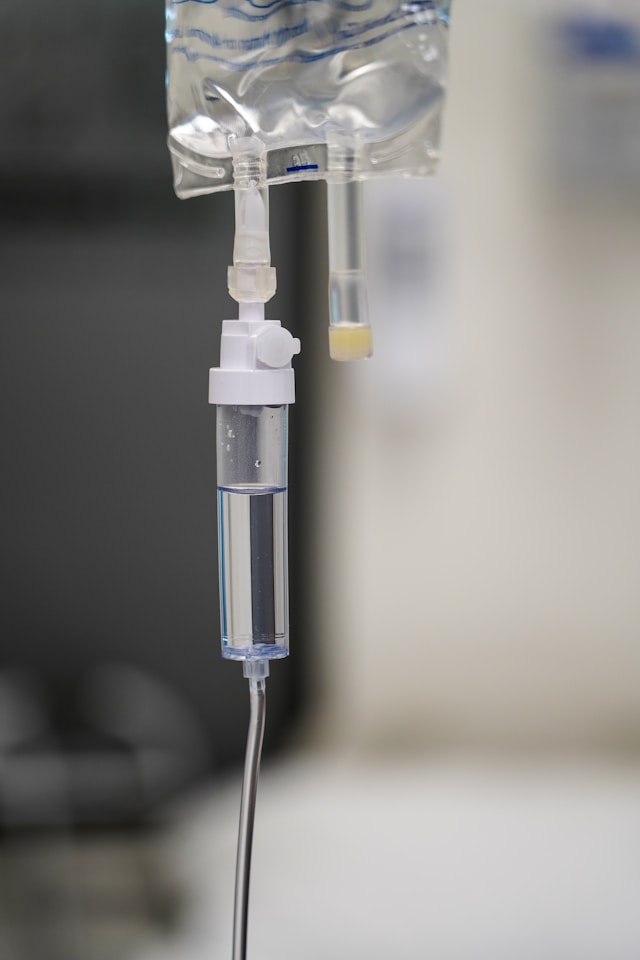
Safety of Infusion Therapy: How Providers Keep Patients Safe


Dr. Chen is a board-certified immunologist with over 15 years of experience treating autoimmune and immunodeficiency disorders. She specializes in IVIG therapy and has published extensively on immune system treatments.
Medical Disclaimer
Safety is naturally one of the biggest concerns when starting infusion therapy. You're receiving powerful medications directly into your bloodstream, often for chronic conditions that require ongoing treatment. Understanding the extensive safety protocols, monitoring systems, and professional standards that protect you during infusion therapy can provide significant peace of mind. Healthcare providers follow rigorous procedures at every step to ensure infusion therapy is administered as safely as possible, and serious complications are rare when treatment is properly managed.
Key Highlights
- Infusion therapy has an excellent safety record, with serious adverse events occurring in less than 1-2% of infusions when administered by trained professionals following established protocols.
- Multiple layers of safety checks—including patient identification verification, medication double-checks, continuous monitoring, and emergency preparedness—protect you throughout treatment.
- Infusion nurses receive specialized training and certification in safe medication administration, IV therapy, and emergency response specific to infusion treatments.
The Foundation of Infusion Therapy Safety
Modern infusion therapy safety is built on decades of research, clinical experience, and continuous improvement of best practices. Organizations like the Infusion Nurses Society establish evidence-based standards that guide how infusion therapy should be safely administered.
All infusion medications undergo extensive clinical trials and rigorous Food and Drug Administration (FDA) review before approval. According to the FDA, these trials involve thousands of patients and years of study to establish that medications are both effective and safe when used according to approved protocols.
Infusion centers, hospital infusion departments, and home infusion agencies must meet accreditation standards from organizations like The Joint Commission or the Accreditation Commission for Health Care. These accreditations require demonstrating compliance with comprehensive safety standards, regular staff training, quality monitoring, and emergency preparedness.
Patient Identification and Medication Verification
One of the most critical safety procedures happens before your infusion even begins—confirming that the right patient receives the right medication at the right dose.
Two-Identifier Patient Verification: Your nurse will ask you to state your full name and date of birth (or verify information on your ID bracelet in hospital settings) before any medication is administered. This happens even if your nurse knows you well from previous visits. This two-identifier system prevents medication errors by ensuring medications are given to the correct patient.
Medication Double-Check: Before starting your infusion, your nurse will verify multiple details about your medication—the drug name, concentration, dose, expiration date, and that it matches your doctor's order. Many facilities require a second nurse to independently verify high-risk medications. The Institute for Safe Medication Practices identifies this double-check system as essential for preventing medication errors.
Barcode Scanning: Many facilities use barcode technology that links your patient identification with your specific medication order. The nurse scans both your wristband and the medication, and the system confirms they match before allowing administration to proceed.
Verbal Confirmation: Your nurse will often ask you to confirm what medication you're receiving, especially if you've had multiple infusions before. This engages you as an active participant in your safety.
Specialized Training and Expertise
The nurses who administer your infusion therapy aren't just general nurses—many have specialized training and certification in infusion therapy:
Infusion Nursing Certification: Many infusion nurses hold credentials like the Certified Registered Nurse Infusion (CRNI) certification, which requires extensive education in IV therapy, infusion medications, vascular access, and complication management. This certification ensures nurses have demonstrated expertise in safe infusion practices.
Ongoing Education: Infusion nurses participate in regular continuing education about new medications, updated safety protocols, and emerging best practices. They receive specific training on each medication they administer, including how to recognize and respond to potential reactions.
Emergency Response Training: All infusion nurses maintain current certification in Basic Life Support (BLS) or Advanced Cardiac Life Support (ACLS) and receive training in managing infusion reactions and medical emergencies. Regular drills and simulations keep these skills sharp.
Medication-Specific Knowledge: For complex medications or those with higher risk profiles, nurses receive specialized training about that specific drug—its mechanism of action, common side effects, serious reactions to watch for, and exact protocols for administration.
Continuous Monitoring Throughout Your Infusion
Your safety is monitored constantly from the moment your infusion begins until after it's completed:
Vital Signs Monitoring: Your blood pressure, heart rate, temperature, and sometimes oxygen levels are checked before your infusion starts, periodically throughout treatment, and after completion. Changes in vital signs can indicate developing reactions that need immediate attention.
Regular Nursing Assessments: Your nurse will check on you frequently—typically every 15-30 minutes or more often for first-time infusions or higher-risk medications. These check-ins aren't just social visits; your nurse is systematically assessing how you're responding to treatment.
IV Site Monitoring: Your nurse regularly inspects your IV site for signs of infiltration (medication leaking into surrounding tissue), phlebitis (vein inflammation), or other issues that need correction.
Patient Self-Reporting: You're encouraged to report any symptoms or concerns immediately. Patients often notice subtle changes before they're visible to healthcare providers, making your input a critical safety component.
Call System Access: You'll always have easy access to a call button or bell to summon your nurse immediately if something doesn't feel right.
The Mayo Clinic emphasizes that this multilayered monitoring approach catches potential problems early, usually before they become serious.
Emergency Preparedness and Response
While serious emergencies during infusion therapy are uncommon, every infusion setting is prepared to respond immediately if one occurs:
Emergency Equipment: All infusion facilities maintain crash carts with emergency medications (epinephrine, antihistamines, corticosteroids, etc.), airway management equipment, defibrillators, and oxygen. This equipment is regularly inspected and immediately available.
Emergency Protocols: Healthcare providers follow established protocols for different types of infusion reactions and medical emergencies. These protocols are practiced regularly so staff can respond quickly and effectively.
Physician Backup: Physicians are either on-site or immediately available by phone to provide guidance during emergencies. For severe reactions, protocols allow nurses to administer emergency medications while simultaneously contacting physicians.
Emergency Medical Services Access: All facilities have systems for rapidly activating 911 and emergency medical services if hospital-level care becomes necessary. Staff are trained in stabilization measures to maintain patient safety until emergency responders arrive.
Transfer Agreements: Freestanding infusion centers and home infusion services have formal agreements with nearby hospitals for rapid patient transfer if needed.
Medication Safety Protocols
Beyond the physical act of administering your infusion, multiple systems ensure medication safety:
Pharmacy Oversight: Hospital and infusion center pharmacists prepare or oversee preparation of infusion medications under sterile conditions. They verify dosing calculations, check for drug interactions, and ensure medications are properly stored and handled.
Cold Chain Management: Medications requiring refrigeration are carefully monitored to ensure they maintain proper temperature from storage through administration. Temperature logs document that medications have been kept at safe temperatures.
Sterile Technique: All IV supplies and medications are maintained using strict sterile procedures to prevent infections. Nurses use antiseptic technique when placing IVs and handling infusion equipment.
Expiration Date Verification: Medications, IV supplies, and equipment are checked for expiration dates before use, and expired items are never administered.
Adverse Event Reporting: Any unexpected reactions or complications are documented and reported through safety monitoring systems. This data helps identify patterns and improve safety protocols.
Preventing Infusion Reactions
Healthcare providers use several strategies to minimize the risk of infusion reactions:
Pre-Medications: Many patients receive antihistamines, acetaminophen, or corticosteroids before their infusion to prevent allergic-type reactions and reduce side effects. This prophylactic approach significantly reduces reaction rates.
Gradual Dose Escalation: For first-time infusions, medications are often started at slower rates and gradually increased if tolerated. This "start low and go slow" approach allows early identification of reactions when medication levels are still relatively low.
Test Doses: For certain high-risk medications, small test doses may be administered before the full infusion to assess tolerance.
Patient History Review: Before each infusion, your medical history, previous reaction history, and current medications are reviewed to identify any new risk factors.
Allergy Documentation: Your allergy history is prominently documented in your medical record, and staff verify this information before administering any medications or IV solutions.
Infection Prevention
Preventing infections related to IV access is a major focus of infusion safety:
Hand Hygiene: Healthcare providers perform hand hygiene before and after any patient contact, following strict protocols established by the Centers for Disease Control and Prevention (CDC).
Skin Antisepsis: Before IV insertion, your skin is thoroughly cleaned with antiseptic solution (typically chlorhexidine or alcohol) and allowed to dry completely.
Sterile Supplies: All IV catheters, tubing, and connectors are sterile and single-use. Nothing is reused between patients.
IV Site Care: Your IV site is monitored for early signs of infection (increased redness, warmth, swelling, pain), and IVs are removed at the first sign of problems.
Limited IV Access: Your IV catheter is accessed only when necessary, and ports or connections are cleaned with antiseptic before each use.
Quality Monitoring and Continuous Improvement
Infusion safety isn't static—it's continuously evaluated and improved:
Incident Tracking: All medication errors, adverse reactions, and near-miss events are tracked and analyzed. Patterns identified through this data lead to improved protocols and additional training.
Regular Audits: Infusion centers undergo regular internal and external audits of safety practices, documentation, and outcomes. Accreditation bodies require demonstrating ongoing compliance with safety standards.
Patient Satisfaction Surveys: Patient feedback about safety concerns or uncomfortable experiences prompts investigation and process improvement.
Staff Competency Assessment: Nurses' skills and knowledge are regularly evaluated through competency assessments, ensuring they maintain high standards of practice.
Protocol Updates: As new evidence emerges about best practices, protocols are updated to incorporate improved safety measures.
Your Role in Infusion Safety
While healthcare providers carry primary responsibility for safety, you play an important role too:
Provide Complete Information: Give accurate, complete information about your medical history, allergies, medications, and previous reactions. Don't minimize or forget to mention anything—details matter.
Ask Questions: If you don't understand something about your treatment, ask for clarification. If something doesn't seem right, speak up.
Report Symptoms Immediately: Don't wait to see if symptoms get better on their own. Tell your nurse about any new or concerning symptoms right away, even if they seem minor.
Follow Instructions: Take prescribed pre-medications as directed, arrive well-hydrated if instructed, and follow any post-infusion guidance you're given.
Verify Information: When asked to confirm your identity or medication, take it seriously. These redundant checks exist specifically to catch errors.
Use Call Systems: Don't hesitate to use your call button if you need assistance or something doesn't feel right.
Frequently Asked Questions
How safe is infusion therapy?
Infusion therapy is very safe when administered by trained professionals following established protocols. Serious adverse events occur in less than 1-2% of infusions. The vast majority of patients complete treatment without significant complications. Minor, manageable side effects like fatigue or headache are more common, but serious reactions are rare and usually respond well to immediate intervention when proper monitoring is in place.
What are the risks of infusion therapy?
Potential risks include infusion reactions (allergic-type responses like itching, flushing, or shortness of breath), IV site complications (infiltration, phlebitis, or infection), medication side effects, and rarely, severe allergic reactions. Long-term risks depend on the specific medication and may include increased infection susceptibility or other medication-specific effects. Your healthcare provider will discuss risks specific to your treatment and how they're monitored and managed.
How do nurses know if something is wrong during an infusion?
Nurses recognize problems through systematic assessment: monitoring vital signs for changes, visually inspecting the IV site and your overall appearance, asking specific questions about how you're feeling, and watching for objective signs like changes in breathing, skin color, or level of alertness. Their training and experience help them distinguish normal variations from concerning changes that need intervention.
Can you have a serious reaction to an infusion?
While serious reactions are possible, they're uncommon, occurring in a very small percentage of infusions. Serious reactions are most likely during first exposures to a medication, which is why first-time infusions involve closer monitoring and more cautious administration. Infusion facilities are equipped and staffed to manage serious reactions immediately, and most respond well to emergency treatment. The risk of serious reaction must be weighed against the benefits of treating your underlying condition.
Are home infusions as safe as clinic infusions?
Home infusion can be very safe for appropriate patients and medications. Home infusion nurses are specially trained, carry emergency equipment and medications, and follow strict safety protocols. However, not all medications or patients are appropriate for home infusion. Patients selected for home infusion typically have established tolerance to their medication through multiple clinic infusions and stable medical conditions. The home environment must also meet safety requirements.
Infusion Therapy Safety Is a Top Priority
The extensive safety systems, specialized training, continuous monitoring, and emergency preparedness that support infusion therapy reflect healthcare's commitment to protecting patients. While no medical treatment is completely without risk, infusion therapy's safety record is strong, and serious complications are rare when proper protocols are followed.
Understanding these safety measures can help you feel more confident and secure as you begin or continue infusion treatment for your condition.
Ready to find an infusion center with rigorous safety standards and experienced staff? Explore accredited infusion providers near you to begin treatment with confidence.
Medical Disclaimer: This content is for educational purposes only and is not a substitute for professional medical advice, diagnosis, or treatment. Always consult your healthcare provider with questions about your medical condition or treatment options.
Article Statistics


Table of Contents
Article Statistics










